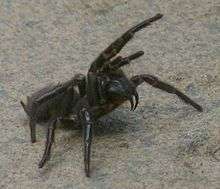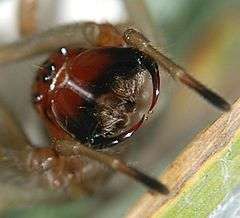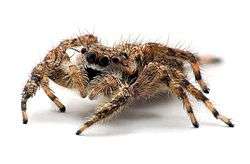Araneomorphae
| Araneomorphae | |
|---|---|
| | |
| Nephila inaurata (Nephilidae) | |
| Scientific classification | |
| Kingdom: | Animalia |
| Phylum: | Arthropoda |
| Subphylum: | Chelicerata |
| Class: | Arachnida |
| Order: | Araneae |
| Suborder: | Opisthothelae |
| Infraorder: | Araneomorphae |
| Diversity | |
| 95 families | |
Araneomorphae (sometimes referred to as Labidognatha) is an infraorder of spiders. They are distinguished by having fangs that oppose each other and cross in a pinching action, in contrast to the Mygalomorphae (tarantulas and their close kin), which have fangs that are nearly parallel in alignment.[1]
Distinguishing characteristics
Note the difference in the orientations of the fangs of the two spiders below, representatives of the Mygalomorphae and the Araneomorphae.
Mygalomorphae

Atrax robustus (a member of the Hexathelidae) is making a threat display, and by so doing shows very clearly the orientation of its fangs, which go up and down, parallel to the long axis of the spider's body. So it is a representative of the suborder Mygalomorphae, not Araneomorphae.
Araneomorphae

In Araneomorphae, the fangs slope towards each other, giving these spiders many more possibilities than Mygalomorphae, which can only bite top down.
Unlike Mygalomorphae, which can live for up to 25 years, most Araneomorphae die after about a year.[2]
Spiders included
Almost all of the familiar spiders are included in this group. The major exception is the tarantulas, which are often seen as pets. The Araneomorphae include the orb-weaver spiders, the cobweb spiders, the crab spiders, the jumping spiders, the wolf spiders, and the large huntsman spiders.
Systematics
As of 2015, precise details of the internal division of the araneomorphs are unclear. There are two main clades: the Haplogynae and the Entelegynae. The position of the two small clades Hypochilidae and Austrochiloidea, remains uncertain: some analyses place them outside the Haplogynae, as shown below.[3] Earlier analyses regarded the Hypochilidae as the sole representatives of a group called the Paleocribellatae, with all other araneomorphs placed in the Neocribellatae.[4] More recent analyses place the Austrochiloidea between the Haplogynae and the Entelegynae,[5] or group the Hypochilidae with the Haplogynae.[6] Most spiders in the Haplogynae have six eyes, while most of those in the Entelegynae series have eight.
| Araneomorphae |
| ||||||||||||
| |
References
| Wikimedia Commons has media related to Araneomorphae. |
| Wikispecies has information related to: Araneomorphae |
- ↑ Foelix, Rainer F. (1996). Biology of Spiders (2nd ed.). New York: Oxford University Press. pp. 4–5. ISBN 0-19-973482-8.
- ↑
- ↑ Coddington, Jonathan A. (2005). "Phylogeny and classification of spiders" (PDF). In Ubick, D.; Paquin, P.; Cushing, P.E. & Roth, V. Spiders of North America: an identification manual. American Arachnological Society. pp. 18–24. Retrieved 2015-09-24.
- ↑ Coddington, Jonathan A. & Levi, Herbert W. (1991). "Systematics and evolution of spiders (Araneae)". Annual Review of Ecology and Systematics: 565–592. JSTOR 2097274.
- ↑ Griswold, C.E.; Ramirez, M.J.; Coddington, J.A. & Platnick, N.I. (2005). "Atlas of phylogenetic data for entelegyne spiders (Araneae: Araneomorphae: Entelegynae) with comments on their phylogeny". Proceedings of the California Academy of Sciences. 56 (Suppl. 2): 1–324. Cited in Bond et al. (2014)
- ↑ Bond, Jason E.; Garrison, Nicole L.; Hamilton, Chris A.; Godwin, Rebecca L.; Hedin, Marshal & Agnarsson, Ingi (2014). "Phylogenomics Resolves a Spider Backbone Phylogeny and Rejects a Prevailing Paradigm for Orb Web Evolution". Current Biology. 24 (15): 1765–1771. doi:10.1016/j.cub.2014.06.034.
